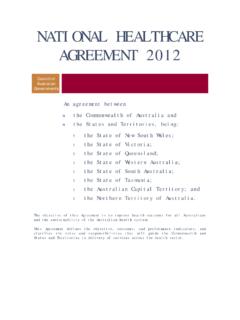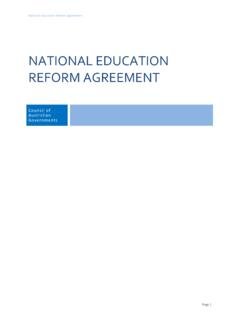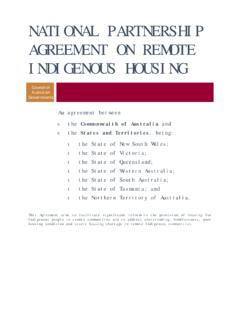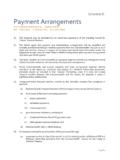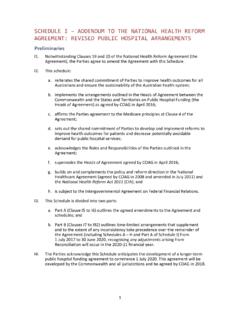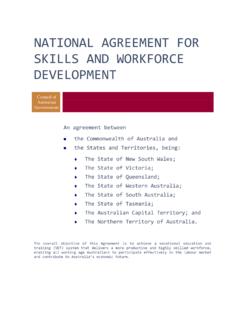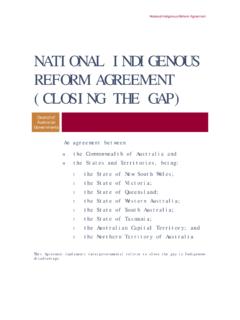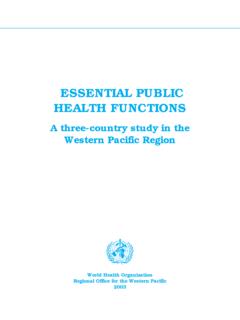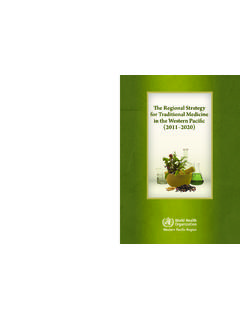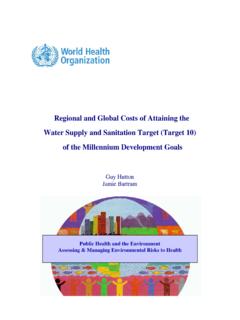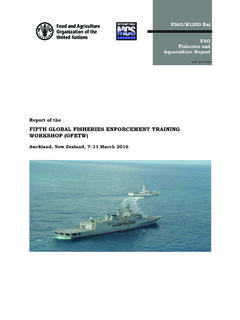Transcription of Bilateral Agreement between the Commonwealth and …
1 Bilateral Agreement between the Commonwealth and western Australia Coordinated care reforms to improve patient health outcomes and reduce avoidable demand for health services Page 1 of 28. Part 1 Preliminaries and Reform Intent 1. The Commonwealth of Australia (the Commonwealth ) and western Australia (WA). acknowledge that while Australia has a high performing health system, some patients with chronic and complex conditions experience the system as fragmented and difficult to navigate. 2. This Bilateral Agreement (the Agreement ) recognises the mutual interest and investment of the Commonwealth and WA in improving the delivery of care for patients with chronic and complex conditions, and reducing avoidable demand for health services. 3. The Agreement sets out a suite of reforms to progress the Council of Australian Government's (COAG) commitment to enhanced coordinated care, as articulated in the Addendum to the National Health Reform Agreement (NHRA): Revised Public Hospital Arrangements for 2017-18 to 2019-20 (the NHRA Addendum).
2 Activities that will progress these reforms are set out in the Schedules to this Agreement (the Schedules). 4. The Agreement complements reforms relating to safety and quality, and Commonwealth funding mechanisms also articulated in the NHRA and existing national and local coordinated care measures. Part 2 Parties and Operation of Agreement Parties to the Agreement 5. The Agreement is between the Commonwealth and WA. Commencement, duration and review of the Agreement 6. The Agreement will commence from the date of the signing of this Agreement . 7. Review of the Agreement will commence from July 2018, to inform COAG's consideration of a joint national approach to enhanced coordinated care for people with chronic and complex conditions in early 2019. 8. The Agreement will expire on 31 December 2019, unless terminated earlier in writing. COAG will consider arrangements beyond this point.
3 Interoperability 9. The Agreement is to be considered in conjunction with: a. The NHRA and the NHRA Addendum;. b. The National Healthcare Agreement 2012; and c. The Intergovernmental Agreement on Federal Financial Relations 2008. 10. Schedules to this Agreement will include, but not be limited to: a. Schedule A: Implementation Plan; and b. Schedule B: Evaluation Framework. Page 2 of 28. Part 3 Objective and Outcomes 11. The overarching objective of the Agreement is to support the implementation of coordinated care reforms, consistent with the principles outlined in the NHRA Addendum, that: a. improve patient health outcomes; and b. reduce avoidable demand for health services. 12. The Parties will contribute to the achievement of these objectives and outcomes through reform activities as specified in Schedule A to this Agreement , including;. a. data collection and analysis; system integration; and care coordination services, as critical underlying structures of joint coordinated care reform; and b.
4 In other priority areas relevant to WA's local needs and circumstances. 13. The Parties recognise that the activities, objectives and outcomes of the Agreement will link, where relevant, to progress longer term health reforms. Data Collection and Analysis 14. Data collection and analysis activities will focus on patients with chronic and complex conditions, including Health Care Homes (HCH) patients, and will link data for these patients, to inform Commonwealth and jurisdictional reforms, by: a. providing an understanding of patient service utilisation and pathways across the health system;. b. identifying patients or patient characteristics that would benefit from better care coordination, including from the HCH model;. c. supporting understanding of the impact of service change, to support improved population health outcomes and inform ongoing health system improvements; and d. contributing to the evidence base for improving patient care.
5 System Integration 15. System integration activities are aimed towards contributing to improvements over time, in: a. regional planning and patient health care pathways, including providing better access and service delivery across systems;. b. integration of primary health care, acute care, specialist and allied health services, including through digital health opportunities; and c. effectiveness and efficiency of collaborative commissioning arrangements. Care Coordination Service 16. Care coordination service activities are aimed towards contributing to improvements over time, in: Page 3 of 28. a. care coordination capacity and capability;. b. cost effectiveness and efficiency of targeting of available resources, while ensuring continuity of care for patients; and c. patient empowerment, knowledge, skills and confidence to set goals and manage their health, with the support of their health and social care team.
6 17. The Parties will additionally contribute to the achievement of the objectives and outcomes of the Agreement through reforms in the priority areas of aged care integration, and end of life care. Part 4 Roles and responsibilities 18. The Parties agree to work together to implement, monitor, refine and evaluate coordinated care reform activities under the Agreement . 19. In respect of the joint commitment at Clauses 11 through 17, the Parties will: undertake all activities as outlined in the Schedules to the Agreement ; develop and agree project plan/s to support implementation, where relevant; monitor achievement against milestones; and conduct an evaluation of reform activities. Part 5 Monitoring progress and evaluation Monitoring Progress 20. Progress will be monitored and reported in accordance with Schedule A: Implementation Plan. This will support early identification and/or resolution of implementation issues, inform refinement of the coordinated care reform activities and policy development, and support evaluation of Agreement activities.
7 21. Monitoring activities will include: a. six-monthly status reports, on an exception basis against relevant milestones, by each Party, to relevant executive officers;. b. quarterly Bilateral officer-level discussions on implementation progress and emerging risks or issues; and c. multilateral updates as required on implementation progress and emerging risks or issues through relevant committees; and d. ad hoc reporting, as agreed by the Parties. 22. The Parties will undertake an initial evaluation of the reforms including, where possible, the impact on patient outcomes and experience, as outlined in Schedule B: Evaluation Framework, consistent with Clauses 10 12 of the NHRA Addendum. The evaluation will consider the first 12 months of activity, from the commencement of the Agreement . 23. Where WA reforms build on or directly support the HCH model, the evaluation will recognise the collaborative partnership and its impact on the outcome of the HCH.
8 Evaluation. Page 4 of 28. 24. Where possible, the evaluation will acknowledge and consider existing national and local measures, and other broader policy changes that affect the operation of the Agreement . 25. Evaluation findings will be used to inform the development of advice to COAG Health Council prior to COAG in early 2019, in order to inform future activities that will continue to build the evidence base for joint action on coordinated care. Risk and Issues Management 26. The Parties agree that they will continually monitor, review and take necessary action to manage risks over the life of the Agreement . 27. Where agreed by both Parties, Schedule A will be updated to reflect any substantive changes or extension to activities to effectively manage identified risks. 28. Each Party agrees to provide the other Party with reasonable prior notice, in writing, on any implementation issues and risks that may impact on the progress or success of the reforms.
9 29. If risks eventuate at any time for either party, the Party with primary responsibility for the risk will work with the other Party to develop agreed mitigation proposals. Part 6 Stakeholders 30. To support appropriate linkages and embed Agreement activities within existing programs and services, the Parties will communicate as appropriate with key stakeholders throughout the life of the Agreement , including through existing communication channels, mechanisms and forums. Part 7 Governance of the Agreement Disputes under the Agreement 31. Any Party may give notice, in writing, to the other Party of a dispute under the Agreement . 32. The Parties will attempt to resolve any dispute at officer-level in the first instance. 33. If the issue cannot be resolved at officer-level, it may be escalated to the relevant executive officers, Ministers and, if necessary, the COAG Health Council and COAG.
10 Variation of the Agreement 34. The Agreement and its Schedules may be amended at any time by Agreement in writing by the Parties. Delegations 35. The Parties may delegate monitoring and reporting of progress on reform activities under this Agreement to appropriate Commonwealth and western Australian officials. Enforceability of the Agreement 36. The Parties do not intend any of the provisions of the Agreement to be legally enforceable. However, this does not lessen the Parties' commitment to the Agreement . Page 5 of 28. Termination of the Agreement 37. Either of the Parties may withdraw from the Agreement at any time by giving six months'. notice of its intention to do so, in writing, to the other Party, the COAG Health Council and COAG. 38. Following notification of a Party's intention to withdraw from the Agreement , the terms of the withdrawal, including the date on which the Party will cease to be a Party, and any legislative changes and other arrangements that may be necessary as a consequence of the withdrawal, will be negotiated in good faith and agreed between the Parties, on a basis which aims to ensure continuity of support for patients with chronic and complex conditions.
